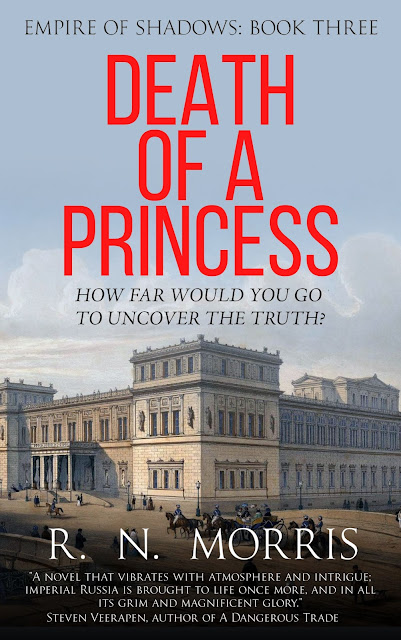For this week's #HistFicThursdays blog, I'm thrilled to be welcoming R. N. Morris to the blog with a guest post about his latest book Death of a Princess, as part of his Coffee Pot Book Club tour. In Roger's guest post, he explains why he loves writing historical crime novels and the influences he has drawn from. But first, let's meet the book...
Summer 1880.
Lipetsk, a spa town in Russia.
The elderly and cantankerous Princess Belskaya suffers a violent reaction while taking a mud bath at the famous Lipetsk Sanatorium. Soon after, she dies.
Dr Roldugin, the medical director of the sanatorium, is at a loss to explain the sudden and shocking death.
He points the finger at Anna Zhdanova, a medical assistant who was supervising the princess’s treatment.
Suspicion also falls on the princess’s nephew Belsky, who appears far from grief-stricken at his aunt’s death.
Meanwhile, investigating magistrate Pavel Pavlovich Virginsky arrives in Lipetsk from St Petersburg, seeking treatment after a nervous breakdown.
Against his better judgement, Virginsky is drawn in to the investigation. But is he getting closer to the truth or walking straight into a deadly trap?
Making Stories Out of History
For me, the best thing about writing historical crime fiction is that it allows you to combine the immersive atmosphere of pure historical fiction with a cracking plot that really pulls the reader in. Like all the best murder stories, you start with a body - it’s just that this body is wearing period costume.
Before I wrote my first historical crime novel (A Gentle Axe) I had written a straight historical novel about the photographer Eadweard Muybridge. Unfortunately, it never found a publisher and it was only really when I made the move to mixing history with mystery that I landed a book deal.
I’ve always been drawn to the past in an imaginative rather than strictly factual way. I don’t think I have the patience to be a proper historian, although I do write factual history podcasts (for example, The Curious History of Your Home, available wherever you listen to your podcasts).
As a novelist, you’re often looking for the gaps in the historical record – the spaces that you can fill with your own stories. The bits, actually, that proper historians must find frustrating!
Of course, when you’re writing historical fiction, you want to be true to your chosen period and setting, as much as you can. To some extent, every age rewrites the past in its own image. Or, to put it another way, historical fiction is a kind of dialogue between the present and the past. That said, I believe the story should come out of an understanding of the period and setting. In my case, in nineteenth century Russia. That’s where your research comes in.
What I’m interested in when I’m researching is not simply the headline historical events and individuals. I’m trying to get a feel for what it must have been like to be alive at that time. What the clothes felt like… How long it took to walk somewhere... The nitty gritty detail that added texture to people’s lives and gives you an insight what was going on in people’s heads. It won’t all go in the book, but it gives me a textural palette to draw from.
I’m also really interested in the ideas, the anxieties, the hopes, aspirations and fears that define the emotional and psychological mood of a period. That’s where the stories will come from.
I find the most useful sources for that kind of psychic universe are novels and memoirs. For nineteenth century Russia I’m extremely well served by writers such as Dostoevsky and Tolstoy. Dostoevsky especially was a great inspiration to me. I even took the main character from my first four books – Porfiry Petrovich – from his great masterpiece, Crime and Punishment.
When I first read Crime and Punishment, I was probably a bit too young to really understand all its philosophical and theological themes. I was simply drawn to the story of an axe-murdering student by the promise of the blurb on the original Penguin Classic edition in my school library. I seem to remember that it described it as the world’s first detective novel, which it isn’t really, though Porfiry Petrovich is a great detective.
Initially, I only intended to write one standalone book. Given that the story was set in Russia, I thought it was going to be enough of a challenge for me to write one book. I didn’t speak Russian (still don’t) and the idea for writing A Gentle Axe was not born out of any deep knowledge of Russia or Russian history. Just out of my enthusiasm for Crime and Punishment. I had a mountain of research to scale and was daunted by the task facing me – even just to produce one book.
But my agent at the time told me that with crime fiction publishers are often interested in a series. He suggested that it might be a good idea for me to have some other story lines up my sleeve. I didn’t really take it seriously at the time. I wasn’t entirely convinced I’d find a publisher for that first book, let alone someone who would want a series.
It turned out that he was right. I ended up writing four Porfiry Petrovich books for Faber and Faber. Recently, my current publisher suggested I write a new series. I decided to make it a spin-off series featuring the investigating magistrate Pavel Pavlovich Virginsky, who had been Porfiry’s sidekick in those earlier books.
Death of a Princess is the third and final book in my Empire of Shadows series, which means I have now written seven books set in tsarist Russia. When I wrote that first book all those years ago, little did I think it would turn into not one but two series.
NB - Each of the books is designed to be read on its own – you don’t need to have read the earlier books to enjoy the latest. Though obviously if you do decide to read them all in sequence, that works too!
A former advertising copywriter, Roger has written the libretto for an opera, modern retellings of Frankenstein and Macbeth for French school children. He’s also a scriptwriter for an award winning audio producer, working on true crime and history podcasts including The Curious History of your Home.
His work has been published in 16 countries.
Married with two grown-up children, Roger lives in Chichester where he keeps an eye out for seagulls.
Website - Twitter - Facebook - LinkedIn - Instagram - Threads - Bluesky - Pinterest - Amazon Author Page - Goodreads




Comments
Post a Comment